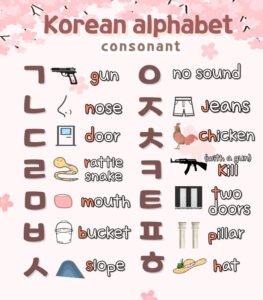To be 이에요/예요/입니다
Hello, welcome to the very first step of your Korean journey!
Now that we’ve learned Korean alphabet, it’s time to move on to basic grammar.
Today we will learn the grammar “이다(이에요/예요)”.
Keep in mind, Korean and English are totally different languages you might encounter some challenges along the way, but don’t worry.! That’s why I’m here to be your guide.
We will learn a grammar point each lesson, with some new vocabulary, and I’ll give you lots of exercises so that you can fully grasp the concept of the grammar.
So It will be
Grasp the concept of grammar -> new vocab list -> exercise/forming sentences on your own to fully understand and use the grammar.
There are lots of language learning methods, and you have to combine all of speaking, listening, reading and writing.
Here, we will be practicing “grammar& writing” part.
You can also access to my listening / expressions materials.
If you want to practice Speaking, It’s the best to go find a native and engage in conversation!
I also offer Korean speaking class, it’s a private class focused on practicing your communication skills.
Then, let’s begin on your Korean journey!
Part 1, Let’s grasp the concept of grammar
This first step, we will be learning the basic verb “to be” like am, are ,is in Korean.
like “I am Mark”. “You are a friend”.
am, are ,is, the “be” verb in Korean is 이다. Do you remember how to read this letter?
it will be ( ee – da) 이다. This is a basic/original verb form.
이다. is the most common way to say “to be” verb. It’s not too formal, not too casual.
And, we will change this verb- depends on the tense. In the present tense, it will be 이에요 / 예요
- 예요 -> when a noun ends in a vowel
- 이에요 – > when a noun ends in a final consonant (batchim)
So, We need to be aware of the sentence order in Korean.
Unlike English, always verbs go to the end.
For instance, in English it will be I like a dog. but In Korean, will be “I a dog like.”
It’s the same that we start with a subject, but let’s make sure.
Verbs/Adjectives are always in the end of a sentence!
So, if we want to say ” I am Sol ” in Korean the order should be : ” I Sol am”.
And depends on the “noun” that’s right in front of this ” Be verb”, which is “am’ in this case,
We will use either 이에요 or 예요.
My name Sol in Korean would be : 솔.
And this one ends in a batchim (= final consonant) (ㄹ), in this case we will use 이에요.
솔이에요. 솔이에요.
How about 마크(Mark) ? to say “He is Mark”. 마크 ends in a vowel, without a final consonant, in this case we will use 예요.
마크예요. 마크예요.
Now try these sentences :
1. I’m 대니
2. You are 진
3. He is 뷔
The answers are :
1.대니예요 (ends in a vowel)
2.진이에요 (ends in a final consonant “ㄴ”(batchim) -> 이에요
3.뷔예요 (ends in a vowel)
Not too hard, right? 이다(이에요/예요) is the informal polite form, which is most commonly used in everyday conversations.
If you want to be extremely polite, you can use 입니다 (im-ni-da)
“입니다” (imnida) is used in formal settings, such as presentations, formal speeches, or when addressing someone in a respectful manner.
This one is a bit easier because we don’t need to think about whether a noun ends in vowel or batchim or not. It’s always the same form: 입니다.
For example:
I am Sol : 솔입니다.
You are James: 제임스입니다.
Let’s sum up!
Informal Polite Forms: 이에요 (ieyo) and 예요 (yeyo)
이다 (ida) is most commonly used in the informal polite form, which is suitable for everyday conversations.
(1) 이에요(ieyo): Used when the noun ends in a consonant.
(2) 예요(yeyo): Used when the noun ends in a vowel.
Examples:
Consonant Ending Noun + 이에요 (ieyo)
This is Subin: 수빈이에요 (subin-ieyo)
Explanation: “수빈” (subin) ends in a consonant(ㄴ), so we use “이에요” (ieyo).
Vowel Ending Noun + 예요 (yeyo)
This is a camera.: 카메라예요 (camera-yeyo)
Explanation: “카메라” (camera) ends in a vowel, so we use “예요” (yeyo).
Formal Polite Form: 입니다 (imnida)
One advantage of “입니다” (imnida) is that it is easier to use because it doesn’t change based on whether the noun ends in a vowel or a consonant. It’s always the same form: 입니다.
Examples:
I am Sol: 솔입니다 (Sol-imnida)
You are James: 제임스입니다 (James-imnida)
Time to practice more!
Part 2, Vocabulary and Exercise
Here is a vocabulary list. Try to familiarize yourself with these words before moving on to the exercises.
We will use this vocabulary to create more sentences on your own.
| Me / I | 나 |
| You | 너 |
| Phone | 폰, 휴대폰 |
| Pen | 펜 |
| Laptop | 노트북 |
| computer | 컴퓨터 |
| Coffee | 커피 |
| Bread | 빵 |
| Cup | 컵 |
| Cake | 케이크 |
Now, try to translate these into Korean, using 이에요/예요 🙂
- It’s me
- I’m Sujan (수잔)
- It’s you
- It’s a phone
- You are Tony (토니)
- It’s a pen
- It’s a laptop
- It’s a computer
- He is Tom (톰)
- It’s coffee
- It’s bread
- It’s a cup
- It’s cake
Let’s check the answers together !
1. It’s me:
나예요 (ending in a vowel) / 나입니다( to be extremely polite)
2. I’m Sujan:
(수잔) 수잔이에요 (ending in a consonant “ㄴ”) / 수잔입니다 (politer)
3. It’s you:
너예요 (ending in a vowel)
4. It’s a phone:
휴대폰이에요/폰이에요 (ending in a consonant “ㄴ”)
5. You are Tony (토니):
토니예요 (ending in a vowel)
6. It’s a pen:
펜이에요 (ending in a consonant “ㄴ”)
7. It’s a laptop:
노트북이에요 (ending in a consonant “ㄱ”)
8. It’s a computer:
컴퓨터예요 (ending in a vowel)
9. He is Tom (톰):
톰이에요 (ending in a consonant “ㅁ”)
10. It’s coffee:
커피예요 (ending in a vowel)
11. It’s bread:
빵이에요 (ending in a consonant “o”)
12. It’s a cup:
컵이에요 (ending in a consonant “ㅂ”)
13. It’s cake:
케이크예요 ( ending in a vowel)
Well done! You’ve done an amazing job mastering the basics of the “이다” verb. Learning a new language can be challenging, but you’re making fantastic progress.
Keep up the great work and stay motivated!😊
In our next lesson, we’ll dive into how to express subjects in sentences like ‘I’ and ‘You.’ Keep pushing forward, and you’ll continue to improve with every step!






